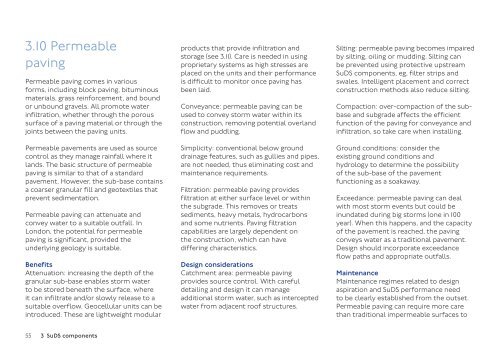SuDS in London - a guide
sustainable-urban-drainage-november-2016
sustainable-urban-drainage-november-2016
You also want an ePaper? Increase the reach of your titles
YUMPU automatically turns print PDFs into web optimized ePapers that Google loves.
3.10 Permeable<br />
pav<strong>in</strong>g<br />
Permeable pav<strong>in</strong>g comes <strong>in</strong> various<br />
forms, <strong>in</strong>clud<strong>in</strong>g block pav<strong>in</strong>g, bitum<strong>in</strong>ous<br />
materials, grass re<strong>in</strong>forcement, and bound<br />
or unbound gravels. All promote water<br />
<strong>in</strong>filtration, whether through the porous<br />
surface of a pav<strong>in</strong>g material or through the<br />
jo<strong>in</strong>ts between the pav<strong>in</strong>g units.<br />
Permeable pavements are used as source<br />
control as they manage ra<strong>in</strong>fall where it<br />
lands. The basic structure of permeable<br />
pav<strong>in</strong>g is similar to that of a standard<br />
pavement. However, the sub-base conta<strong>in</strong>s<br />
a coarser granular fill and geotextiles that<br />
prevent sedimentation.<br />
Permeable pav<strong>in</strong>g can attenuate and<br />
convey water to a suitable outfall. In<br />
<strong>London</strong>, the potential for permeable<br />
pav<strong>in</strong>g is significant, provided the<br />
underly<strong>in</strong>g geology is suitable.<br />
Benefits<br />
Attenuation: <strong>in</strong>creas<strong>in</strong>g the depth of the<br />
granular sub-base enables storm water<br />
to be stored beneath the surface, where<br />
it can <strong>in</strong>filtrate and/or slowly release to a<br />
suitable overflow. Geocellular units can be<br />
<strong>in</strong>troduced. These are lightweight modular<br />
products that provide <strong>in</strong>filtration and<br />
storage (see 3.11). Care is needed <strong>in</strong> us<strong>in</strong>g<br />
proprietary systems as high stresses are<br />
placed on the units and their performance<br />
is difficult to monitor once pav<strong>in</strong>g has<br />
been laid.<br />
Conveyance: permeable pav<strong>in</strong>g can be<br />
used to convey storm water with<strong>in</strong> its<br />
construction, remov<strong>in</strong>g potential overland<br />
flow and puddl<strong>in</strong>g.<br />
Simplicity: conventional below ground<br />
dra<strong>in</strong>age features, such as gullies and pipes,<br />
are not needed, thus elim<strong>in</strong>at<strong>in</strong>g cost and<br />
ma<strong>in</strong>tenance requirements.<br />
Filtration: permeable pav<strong>in</strong>g provides<br />
filtration at either surface level or with<strong>in</strong><br />
the subgrade. This removes or treats<br />
sediments, heavy metals, hydrocarbons<br />
and some nutrients. Pav<strong>in</strong>g filtration<br />
capabilities are largely dependent on<br />
the construction, which can have<br />
differ<strong>in</strong>g characteristics.<br />
Design considerations<br />
Catchment area: permeable pav<strong>in</strong>g<br />
provides source control. With careful<br />
detail<strong>in</strong>g and design it can manage<br />
additional storm water, such as <strong>in</strong>tercepted<br />
water from adjacent roof structures.<br />
Silt<strong>in</strong>g: permeable pav<strong>in</strong>g becomes impaired<br />
by silt<strong>in</strong>g, oil<strong>in</strong>g or mudd<strong>in</strong>g. Silt<strong>in</strong>g can<br />
be prevented us<strong>in</strong>g protective upstream<br />
<strong>SuDS</strong> components, eg, filter strips and<br />
swales. Intelligent placement and correct<br />
construction methods also reduce silt<strong>in</strong>g.<br />
Compaction: over-compaction of the subbase<br />
and subgrade affects the efficient<br />
function of the pav<strong>in</strong>g for conveyance and<br />
<strong>in</strong>filtration, so take care when <strong>in</strong>stall<strong>in</strong>g.<br />
Ground conditions: consider the<br />
exist<strong>in</strong>g ground conditions and<br />
hydrology to determ<strong>in</strong>e the possibility<br />
of the sub-base of the pavement<br />
function<strong>in</strong>g as a soakaway.<br />
Exceedance: permeable pav<strong>in</strong>g can deal<br />
with most storm events but could be<br />
<strong>in</strong>undated dur<strong>in</strong>g big storms (one <strong>in</strong> 100<br />
year). When this happens, and the capacity<br />
of the pavement is reached, the pav<strong>in</strong>g<br />
conveys water as a traditional pavement.<br />
Design should <strong>in</strong>corporate exceedance<br />
flow paths and appropriate outfalls.<br />
Ma<strong>in</strong>tenance<br />
Ma<strong>in</strong>tenance regimes related to design<br />
aspiration and <strong>SuDS</strong> performance need<br />
to be clearly established from the outset.<br />
Permeable pav<strong>in</strong>g can require more care<br />
than traditional impermeable surfaces to<br />
55 3 <strong>SuDS</strong> components


